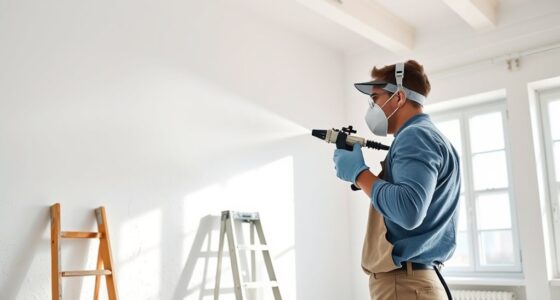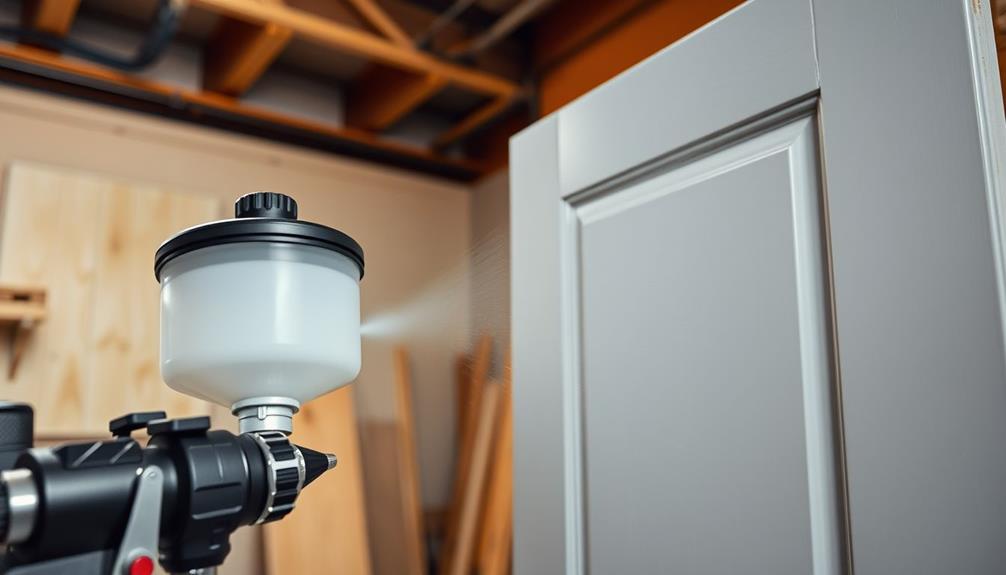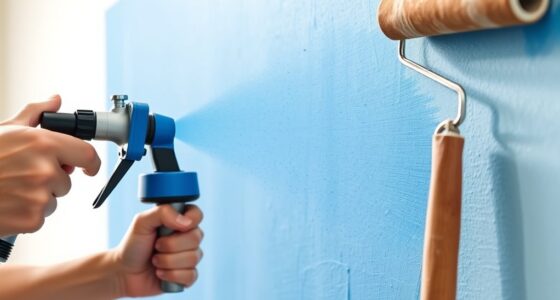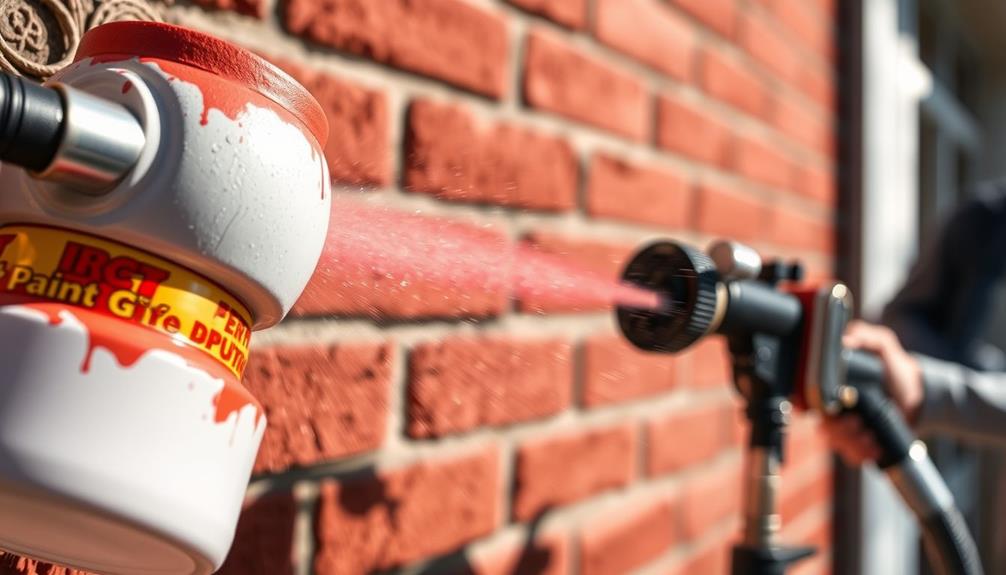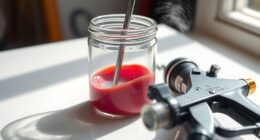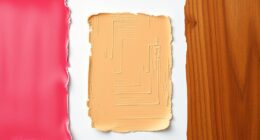For the best results with an airless sprayer, choose primers designed for spray application, like bonding or stain-blocking primers, to guarantee good adhesion and prevent bleed-through. Select paints formulated for airless systems that have suitable viscosity and particle size to avoid clogging, such as latex for walls or durable alkyds for trim. Use stains compatible with spray systems, applying thin coats for even coverage. Proper cleanup and maintenance are key—continue to learn how to keep your sprayer running smoothly.
Key Takeaways
- Use primers designed for airless systems to improve adhesion and prevent peeling on various surfaces.
- Select paints with appropriate viscosity and formulation for airless spraying to ensure smooth, clog-free application.
- Opt for stains compatible with airless sprayers, such as semi-transparent or transparent types, for even penetration.
- Dilute thicker paints slightly and maintain proper spray pressure for optimal flow and finish quality.
- Clean and maintain your sprayer thoroughly after each use to prevent clogs and ensure consistent performance.
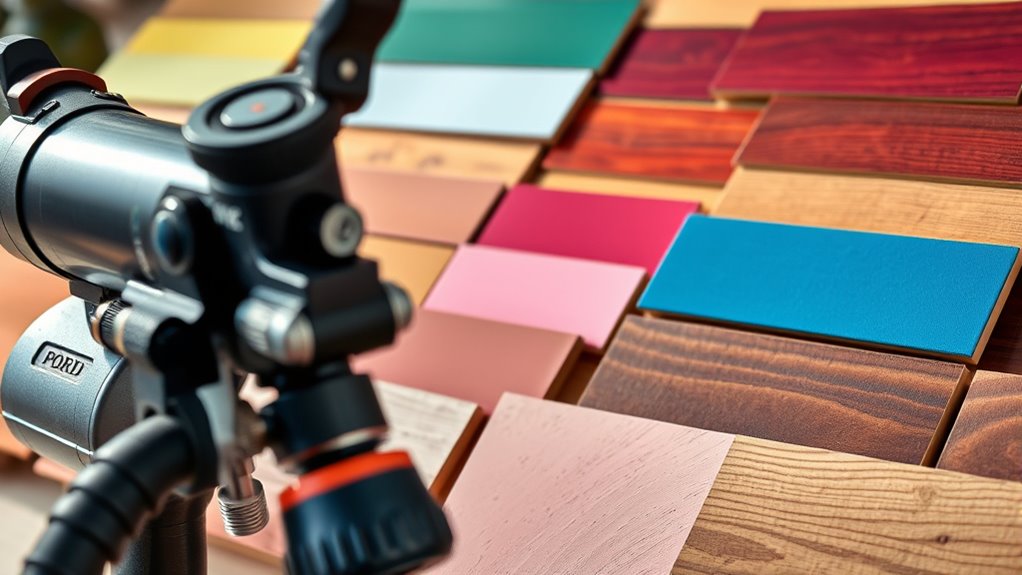
Have you ever wondered how to achieve a flawless finish on your walls or furniture? When you’re working with an airless sprayer, choosing the right primer, paint, or stain makes all the difference. Airless spraying offers a fast, efficient way to cover large surfaces smoothly, but to get that professional look, you need to understand what works best for each product. Primers are your first line of defense; they prepare surfaces, seal pores, and improve adhesion. If you’re tackling bare drywall, a high-quality bonding primer is essential to prevent future peeling and guarantee your paint sticks well. For wood surfaces, especially those prone to tannin bleed or knots, a stain-blocking primer is your best bet. Using the right primer not only enhances the color and finish but also extends the lifespan of your project.
When it comes to paints for airless spraying, the key is selecting the right viscosity. Thinner paints spray more evenly and reduce clogging, so you might need to dilute thicker paints slightly. Latex paints are popular for walls because they’re easy to work with, quick-drying, and clean up with water. However, if you want a durable, high-gloss finish on trim or furniture, oil-based or alkyd paints might be better—they provide a tougher coating, but they require mineral spirits for cleanup. Always check the manufacturer’s recommendations for your sprayer; some paints are formulated specifically for airless systems, with the right viscosity and particle size to prevent spray tip clogging.
Stains are trickier because they penetrate wood rather than just coating it. For staining with an airless sprayer, you’ll want to choose a product designed for spray application, often a semi-transparent or transparent stain. These penetrate deeply and highlight the wood’s natural grain. To get an even finish, apply multiple thin coats rather than one thick layer. Using a compatible primer before staining can also help prevent blotchiness, especially on uneven or soft woods. When spraying stains, keep the pressure consistent and maintain a steady distance from the surface to avoid drips or uneven coverage. Cleaning your sprayer immediately after use with the appropriate solvent is vital to keep it functioning smoothly and extend its lifespan.
Frequently Asked Questions
Can I Use Oil-Based Primers With Water-Based Paints?
Yes, you can use oil-based primers with water-based paints, but it’s not always ideal. Oil-based primers provide excellent adhesion and stain blocking, which benefits certain surfaces. However, they may take longer to dry and can cause compatibility issues, like peeling or poor adhesion, if not properly prepared. For the best results, verify the primer fully dries and follows the manufacturer’s recommendations. Always test a small area first to avoid future problems.
How Do Weather Conditions Affect Spray Application Quality?
Weather’s impact is the silent sculptor of your spray job’s success. When it’s too hot, paint dries too fast, causing uneven coverage. Cold, or high humidity, can lead to poor adhesion and longer drying times. Wind stirs up debris and causes overspray, wasting material. To guarantee top quality, spray in mild, dry conditions, and always check weather forecasts—your best ally in achieving a flawless finish.
Are There Eco-Friendly or Low-Voc Options for Primers and Paints?
Yes, there are eco-friendly and low-VOC primers and paints available. You can choose products labeled as zero or low-VOC, which emit fewer harmful fumes and are better for the environment. Look for brands committed to sustainability, and consider water-based options over solvent-based ones. These products often perform just as well, so you can achieve your desired finish while reducing your environmental impact.
What Maintenance Is Required for Airless Spray Equipment?
Your airless spray equipment needs regular maintenance to keep it running like a well-oiled machine. After each use, clean the spray gun, nozzle, and filters thoroughly to prevent clogs. Check the hoses for wear and tear, and lubricate moving parts as recommended. Periodically inspect seals and replace them if needed. Proper maintenance guarantees smooth operation, extends your equipment’s lifespan, and guarantees flawless finishes every time you spray.
How Long Should I Wait Between Primer and Paint Coats?
You should wait at least 2 to 4 hours between primer and paint coats, but it depends on the specific products used and environmental conditions. Check the manufacturer’s instructions for exact drying times, as factors like temperature and humidity can affect curing. Confirm the primer is fully dry and tack-free before applying the next coat to achieve the best adhesion and finish. Patience here guarantees a durable, smooth result.
Conclusion
Choosing the right primer, paint, or stain can transform your project from dull to dazzling. While primers lay the foundation, paints and stains add the final touch, each with their own strengths. Think of primers as the quiet starters and paints or stains as the bold finishers. By understanding their roles, you’ll guarantee your airless sprayer delivers flawless results every time, turning a simple task into a stunning transformation.



